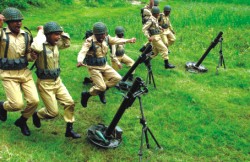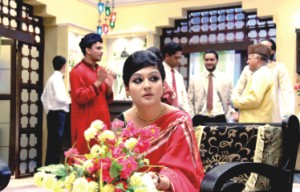|
Film Review

A Tribute to the Guerrillas
The story of real life guerrillas who carried out operations in Dhaka city
in 1971 is told through the quest of a female freedom fighter– Bilkis
Tamanna Khan
 |
Photos: courtesy |
Unlike most other films on Liberation War, made in recent times, Nasiruddin Yousuff's 'Guerrilla' is not a love story or account of people fleeing the war-ravaged country or of the war only as a backdrop. Guerrilla is the story of real guerrilla fighters, the group that was active in Dhaka- the captive capital of East Pakistan. It is the story of Rumi, Bodi, Jewel, Azad, Altaf Mahmud, Shahdat, Alam – all real life freedom fighters. For the first time these heroes of our war come out from the pages of memoirs and reflections by comrades and appear on the silver screen.
Based on Syed Shamsul Haq's novel Nishiddho Loban and Yousuff's own experiences of the Liberation War, the film recounts the guerrilla activities not through a male figure as in most war films but through a female freedom fighter, Bilkis. Played by Joya Ahsan, Bilkis, is a woman brought into the war circumstantially. The story begins on the night of March 25, 1971 when Bilkis's husband Hasan, a journalist, goes out on an assignment never to return. Bilkis's grief is shown as private, and in between the scenes of resistance and genocide by Pakistani army, the moment that provides Bilkis with the strength to launch a search mission for her husband is lost.
As a result towards the beginning of the story, the audience remains in the dark about the relation between the characters and their activities. Once Altaf Mahmud enters the scene, the characters begin to find their relevance. Although the script initially struggles to fit in the different aspects of captive Dhaka and organisation of guerrilla activities in the city, it picks up the pace towards the middle when Bilkis's role as an intermediary, a messenger, logistics provider and an active guerrilla becomes clear.
The best thing about the film is the near-to-perfect rebuilding of Dhaka of the East Pakistan times. The director has taken care of every detail; from Bilkis's saris, earrings, and bags to the signs in front of the office, banners and graffiti, the old taxis of Dhaka called scooter, cars, train, helicopter, jeeps– everything match the pre-liberation period. Recreating Dhaka of the 60s and early 70s must have been a tough job, but Yousuff has scored well in this task.
 |
Photos: courtesy |
The war itself makes a graphic and vivid presence in this film unlike other recently released Liberation War films where the actual fighting only comes through narrations and discussions by characters and a few footages of operations. Yousuff has used actual ammunition and the blasts and the aircrafts all are from real time, not from old records. Guerrilla makes a difference also in depicting not only the attacks of the Pakistani military but also the initial resistance by police and East Pakistan Rifles. In fact, the myriads of bullets, grenades, bombs, and dead bodies almost take the viewers to 1971.
Furthermore, the film probably is the first one, where the Pakistani military persons are not anonymous army personnel but real people- like Rao Farman Ali and other Pakistani officers like Major Sarforaz and Captain Shamsad and IB Humayun. Their direct involvement in the killings, torture and rape and ordering war crimes is boldly depicted in the film. The director does not even try to camouflage collaborators like Golam Azam and his political banner campaigning for the execution of Sheikh Mujibur Rahman is seen hanging in the streets of Dhaka.
In terms of acting, Joya Ahshan's performance has been excellent but the award-winner for Guerrilla should be Shatabdi Wadud playing the role of the Pakistani generals Sarforaz and Shamsad. From his almost perfect delivery of dialogues in English and Urdu to the expression of his face, his make-up, his sneers – all make him a despised Pakistani general. His dramatic annihilation at the end, which probably has been shown as an allegory to the defeat of the Pakistanis, is rejoiced among the audience. The other actors and actresses too have performed well implying a good team work in the crew.
The music of the film and the background songs are well suited, balanced and inspiring. Shimul Billah's deep melancholic voice touches the heart when Bilkis's loneliness amidst the war is presented. The visual work of the film is equally beautiful and becomes lyrical as Bilkis while heading back home recalls her childhood. Her brother's death after those scenic visuals becomes heart-breaking to the point that sniffles in the cinema hall can no longer be subdued.
Although Guerrilla is an excellent depiction of one of the strategies that our freedom fighters had to resort to in order to break the backbone of the trained Pakistani Armed Forces, the scope of the film remains limited. It provides very little background of the war and its causes. Also the huge displacement of population does not appear in too much detail. However, it is almost impossible to put all the aspects of a nine-month war in a film. If viewers are looking forward to learning the detailed history of our Liberation War, then Guerrilla probably cannot provide that. A first hand idea about the real life characters shown in the film is probably a prerequisite to fully appreciate the film. But what Guerrilla does is bring to life a volley of emotions that culminate in acts of unbelievable bravery. That in itself can be seen as the film's biggest success. |

